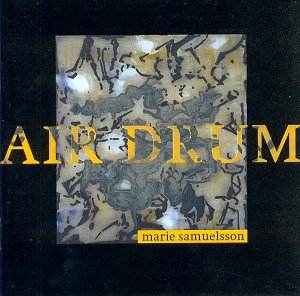Lufttrumma III
("Air Drum"), which opens
this composer’s portrait and gives it
its collective title, is a brilliant
and noisy concert opener with many arresting
orchestral sounds. The scoring, appropriately
enough includes a prominent part for
metal drums. It is particularly striking
and conjures-up visions of some cracked
landscapes, quite impressively so, I
must say, while displaying a formidable
energy.
Nature, in one way
or another, is rarely absent from Marie
Samuelsson’s output, i.e. as far as
I can judge from the works recorded
here. This is particularly so in I
vargens öga ("In the
Eye of the Wolf") for saxophone
and tape, in which instrument and taped
sounds (mainly wolf’s howling, at times
modified electronically) first oppose
each other before progressively blending
and, by so doing, reaching some sort
of final ambiguity.
Krom
("Chrome") for brass quintet
is a splendid work, "rock solid",
to quote Eva Runefelt’s apt phrase.
This is the kind of stuff that should
appeal to all brass quintets looking
for some unfamiliar, worthwhile new
works, fairly virtuosic at times (as
in the opening section, somewhat reminiscent
of Malcolm Arnold) and superbly written
throughout, with many impressive moments.
I Am – Are You?
for horn, voice (Dana Johnson in this
recording) and tape is, at about ten
minutes, one of the longest works in
this selection of Samuelsson’s music.
The voice on tape keeps repeating some
words and phrases, and is echoed (answered,
contradicted) by the horn. So far, so
good; but I found this piece a bit too
long for its own good and marginally
less satisfying than most other pieces
recorded here. Sören Hermansson’s
delivery of the often exacting and brilliant
horn part is superb.
Flow
for chamber ensemble displays another
facet of Samuelsson’s music, which is
almost minimalist here, but more like
the music of Louis Andriessen than that
of Steve Reich, if you see what I mean
: not the gentle, immaculate and softly
modulating sort of Minimalism but rather
the more rugged, sharp-edged and strongly
contrasted Minimalism favoured by the
Dutch composer.
Ö
("Island") is on the whole
simpler. This is a fairly traditional
arch-form fantasy for solo violin (wonderfully
played by Anna Lindal) exploiting the
many facets of the instrument without
ever using extravagant playing techniques.
This is definitely a virtuoso piece
calling both for immaculate technique
and imagination on the player’s part.
Rotationer
("Rotations") for string orchestra
is, I firmly believe, the unquestionable
unquestioned gem in this collection.
A beautifully crafted study in string
writing, much along the same lines as
Ö, i.e. roughly in
arch-form. It starts somewhat hesitantly,
gains considerable momentum through
dense counterpoint and slowly retraces
its way back to darkness. This is a
minor masterpiece and should be eagerly
taken-up by string orchestras. Wonderful
playing here from the Helsingborg Symphony
Orchestra.
The last piece Den
natten ("That Night")
for mixed chorus is probably the most
readily accessible work here. It provides
for an appeased, easy-going conclusion
to this worthwhile survey of Samuelsson’s
often gripping, tense, uncompromising
but highly communicative music.
Marie Samuelsson, whose
music was new to me, is a distinguished
composer who is not afraid of using
the whole gamut of modern techniques,
when they suit her purposes. She has
a clear view of how she wants her music
to communicate. Her music, by turns
disarmingly simple or overtly complex;
is well served here by performers of
high calibre. They obviously strongly
(and rightly so, I think) believe in
it and play it in the most convincing
way, making the best of it. I would
like to hear more of this composer in
the future.
Hubert Culot
